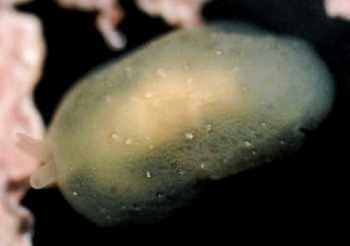
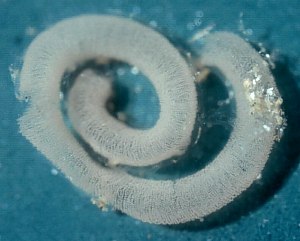
Berthella strongi
(MacFarland, 1966)
Order: NOTASPIDEA
Superfamily: PLEUROBRANCHOIDEA
Family: Pleurobranchidae
DISTRIBUTION
From central California, USA to Punta Rosarito, Baja California, Mexico. One record from British Columbia
PHOTO
UPPER: Bird Rock, La Jolla, California, USA. June 2000. Animal approx 11 mm long. LOWER: Egg mass. Punta Rosarito, Baja California, May 2001. Photos: Jeff Goddard.
Basically the external difference between B. strongi and B. californica is the texture of the notal surface - B. califonica being tuberculate, while B. strongi is smooth. Also, B. californica has a thin white line along the margin of the mantle, which is lacking in B. strongi. [see Dave Behren's message]. From photos on the Forum, another distinction would appear to be the shape of the egg mass, wide and flat in B. californica, cylindrical in B. strongi.
Reference:
• Gosliner, T.M. & Bertsch, H. (1988). A review of the genus Berthella (Opisthobranchia: Notaspidea) from the Pacific Coast of North America. The Veliger, 31: 46-67.
Rudman, W.B., 2002 (March 18) Berthella strongi (MacFarland, 1966). [In] Sea Slug Forum. Australian Museum, Sydney. Available from http://www.seaslugforum.net/find/bertstro
Related messages
Sponge prey of Berthella from the NE Pacific
July 20, 2007
From: Jeff Goddard
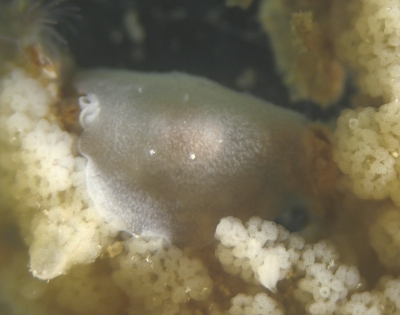
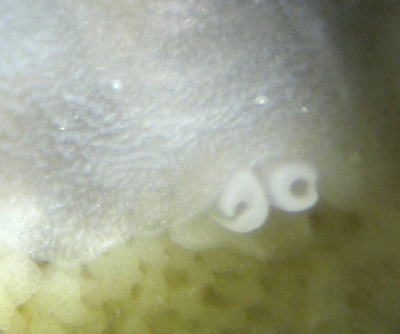
Hi Bill,
Here are some images of Berthella strongi feeding on the plakinid sponge Oscarella carmela, plus one image taken by Dr. Stewart Schultz last summer of O. carmela from Cape Arago, Oregon. Last year I found four individuals of B. strongi on this sponge near Santa Barbara and was able to document feeding by all four on the sponge in the lab. Last summer I also had an opportunity to test whether two B. californica from Cape Arago, Oregon would prey on Oscarella carmela or the superficially similar Halisarca sacra from the same locality. Both individuals consumed only the Oscarella.
Locality: Ellwood boulder field, Low intertidal, California, USA, Pacific Ocean, 7 October 2006, Rocky shore. Length: 5 mm. Photographer: Jeff Goddard.
Prey records are now available for six species of Berthella from around the world. All feed on plakinid sponges, suggesting that Berthella specialize on this family of sponges. Recent evidence indicates that plakinid homoscleromorph sponges are more closely related to the Eumetazoa than to other sponges, so they have been getting some fairly widespread attention.
I document these new prey records for Berthella in a paper just published in The Veliger, and before too long hope to investigate the diet of B. ilisima, the large and conspicuous species from the more southerly Panamic biogeographic province.
-
Goddard, J.H.R. (2007) Berthella (Opisthobranchia: Pleurobranchidae) from the Northeast Pacific Ocean Prey on Plakinid Sponges (Homoscleromorpha: Plakinidae). The Veliger 49 (2): 97-100.
Best wishes,
Jeff
goddard@lifesci.ucsb.edu
Goddard, J.H.R., 2007 (Jul 20) Sponge prey of Berthella from the NE Pacific. [Message in] Sea Slug Forum. Australian Museum, Sydney. Available from http://www.seaslugforum.net/find/20217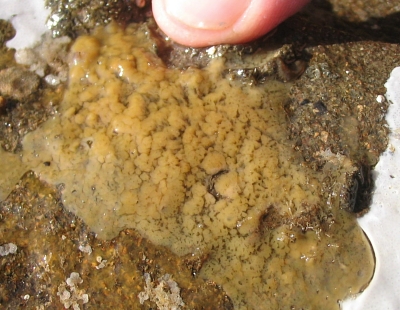
Dear Jeff,
Thanks for keeping us up to date with your research. As we learn more about feeding in the opisthobranchs it appears that there are very few generalists. I won't be surprised - if I last long enough - if most species turn out to be highly specialised feeders retricting their food to a very few species.
Best wishes,
Bill Rudman
New photo of Berthella strongi
November 27, 2003
From: Ken Ashman

Dr. Rudman -
I thought you might like this image of Berthella strongi - it shows the texture of it's skin. I came across the slug at San Miguel Island, California, at about 35ft.
Ken Ashman
kenashman@charter.net
Ashman, K., 2003 (Nov 27) New photo of Berthella strongi. [Message in] Sea Slug Forum. Australian Museum, Sydney. Available from http://www.seaslugforum.net/find/11519Thanks Ken,
One of the main external differences between this and Berthella californica is that this species has a smooth mantle while in B. californica the larger white spots are on raised tubercles. The smooth nature of the skin can be seen clearly in your photos.
The presence of sea anemones in the photo make me wonder just what this species eats. Dave Behrens (1980) reports it being associated with compound ascidians, which may well be its food, but I don't know of any sightings of it actually feeding
Best wishes
Bill Rudman
Berthella strongi from southern California
April 10, 2002
From: Jeff Goddard

Hi Bill,
In response to a question on the Forum last month about Berthella strongi, I have enclosed a photo of a Berthella strongi (MacFarland, 1966) that I found under an intertidal cobble at Bird Rock, La Jolla, California in June 2000. The specimen was about 11 mm long.
This species generally ranges from Moss Beach, central California (Bertsch et al., 1972) to Punta Rosarito, Baja California (Goddard & Schickel, 2000). However, Behrens (1998) reported a specimen found by Mike Miller off of Nanaimo, British Columbia. This latter record may have been an anomalous range extension associated with the 1997-1998 El Nino event. I don't have any information on the diet of this species.
I have also included a photo of the egg mass of Berthella strongi. It was laid by a specimen collected at Punta Rosarito in May 2001. Planktotrophic veliger larvae hatched after 8 days at 18 degrees C. Like other members of the order, the larvae hatched with eyespots and a deeply pigmented mantle organ, but without an operculum. The lack of an operculum during ontogeny is rare among benthic opisthobranchs with indirect development and is known only in the pleurobranchacean notaspideans and dorid nudibranchs in the genus Aegires (Goddard, 2001).
References
• Behrens, D. W. (1998) Locality data: Berthella strongi (MacFarland, 1966). Opisthobranch Newsletter 24:30
• Bertsch, H., T. Gosliner, R. Wharton & G. Williams (1972) Natural history and occurrence of opisthobranch gastropods from the open coast of San Mateo County, California. The Veliger, 14: 302-314.
• Goddard, J. H. R. (2001) The early veliger larvae of Aegires albopunctatus (Nudibranchia: Notodorididae), with morphological comparisons to members of the Notaspidea. The Veliger, 44: 398-400.
• Goddard, J. H. R. & E. Schickel (2000) Range extensions of six opisthobranchs to Punta Rosarito, Baja California. Opisthobranch Newsletter, 26: 21-22.
Jeff Goddard
goddard@lifesci.ucsb.edu


Thanks Jeff,
Its good to be able to fill the gap. It looks from Steve Gardner's photo that the egg mass of Berthella californica is wider and flatter than that of B. strongi.
Bill Rudman
Re: Berthella strongi
March 21, 2002
From: Dave Behrens
Concerning John Dorsey's message. Wish I had a scan of B. strongi. Basically the external difference between B. strongi and B. californica is the texture of the notal surface, B. califonica being tuberculate, B. strongi is smooth. Also, B. californica has a thin white line along the margin of the mantle, which is lacking in B. strongi. Two color variations of each species are shown in Pacific Coast Nudibranchs.
Dave Behrens
dave@seachallengers.com
Behrens, D., 2002 (Mar 21) Re: Berthella strongi. [Message in] Sea Slug Forum. Australian Museum, Sydney. Available from http://www.seaslugforum.net/find/6503Thanks Dave,
Bill Rudman
Berthella strongi
March 20, 2002
From: John Dorsey
I'm curious about Berthella strongi not being listed along with the other species of Berthella on the Forum. I see Berthella californica which looks similar to Berthella strongi.
John Dorsey
john.dorsey@aspect.com
Dorsey, J., 2002 (Mar 20) Berthella strongi. [Message in] Sea Slug Forum. Australian Museum, Sydney. Available from http://www.seaslugforum.net/find/6478Dear John,
There's nothing sinister in the absence of Berthella strongi from the Forum. The Forum is to a large extent 'consumer-driven'. I am happy to add a species to the list whenever someone asks a question about it or preferably sends a photo. If you have photos or observations about this species you would like to share, they would be very welcome.
Best wishes,
Bill Rudman
